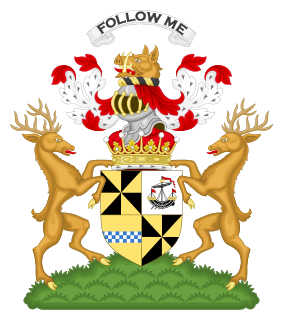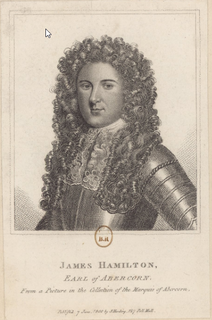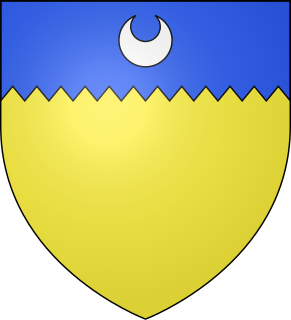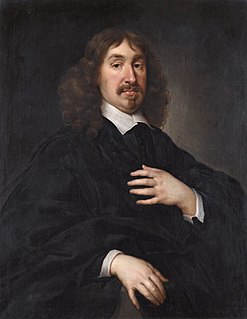
Marquess of Aberdeen and Temair, in the County of Aberdeen, in the County of Meath and in the County of Argyll, is a title in the Peerage of the United Kingdom. It was created on 4 January 1916 for John Hamilton-Gordon, 7th Earl of Aberdeen.

Earl of Derby is a title in the Peerage of England. The title was first adopted by Robert de Ferrers, 1st Earl of Derby, under a creation of 1139. It continued with the Ferrers family until the 6th Earl forfeited his property toward the end of the reign of Henry III and died in 1279. Most of the Ferrers property and the Derby title were then held by the family of Henry III. The title merged in the Crown upon Henry IV's accession to the throne in 1399.

The title Duke of Abercorn is a title in the Peerage of Ireland. It was created in 1868 and bestowed upon James Hamilton, 2nd Marquess of Abercorn. Although the Dukedom is in the Peerage of Ireland, it refers to Abercorn, West Lothian, and the Duke also bears four titles in Peerage of Scotland and two in the Peerage of Great Britain, and is one of only three peers who have titles in those three peerages. The Duke of Abercorn also claims the French title of Duke of Châtellerault, created in 1548.

Duke of Argyll is a title, created in the Peerage of Scotland in 1701 and in the Peerage of the United Kingdom in 1892. The Earls, Marquesses, and Dukes of Argyll were for several centuries among the most powerful noble families in Scotland. As such, they played a major role in Scottish history throughout the 16th, 17th, and 18th centuries. The Duke of Argyll also holds the hereditary titles of chief of Clan Campbell and Master of the Household of Scotland.

Duke of Hamilton is a title in the Peerage of Scotland, created in April 1643. It is the senior dukedom in that Peerage, and as such its holder is the Premier Peer of Scotland, as well as being head of both the House of Hamilton and the House of Douglas. The title, the town of Hamilton in Lanarkshire, and many places around the world are named after members of the Hamilton family. The ducal family's surname, originally "Hamilton", is now "Douglas-Hamilton". Since 1711, the Dukedom has been held together with the Dukedom of Brandon in the Peerage of Great Britain, and the Dukes since that time have been styled Duke of Hamilton and Brandon, along with several other subsidiary titles.

The Duke of Roxburghe is a title in the peerage of Scotland created in 1707 along with the titles Marquess of Bowmont and Cessford, Earl of Kelso and Viscount Broxmouth. John Ker, 5th Earl of Roxburghe became the first holder of these titles. The title is derived from the royal burgh of Roxburgh in the Scottish Borders that in 1460 the Scots captured and destroyed.

Duke of Atholl, alternatively Duke of Athole, named after Atholl in Scotland, is a title in the Peerage of Scotland held by the head of Clan Murray. It was created by Queen Anne in 1703 for John Murray, 2nd Marquess of Atholl, with a special remainder to the heir male of his father, the 1st Marquess.

Earl of Stair is a title in the Peerage of Scotland. It was created in 1703 for the lawyer and statesman John Dalrymple, 2nd Viscount of Stair.

Lord Elibank, of Ettrick Forest in the County of Selkirk, is a title in the Peerage of Scotland. It was created in 1643 for Sir Patrick Murray, 1st Baronet, with remainder to his heirs male whatsoever. He had already been created a Baronet, of Elibank, in the Baronetage of Nova Scotia in 1628. His great-great-grandson, the fifth Lord, was an author and economist. He was succeeded by his younger brother, the sixth Lord, who was an admiral in the Royal Navy. On his death the titles passed to his nephew, the seventh Lord. He represented Peeblesshire in the House of Commons and also served as Lord Lieutenant of Peeblesshire.
Lord Belhaven and Stenton, of the County of Haddington, is a Lordship of Parliament in the Peerage of Scotland. It was created in 1647 for Sir John Hamilton, 2nd Baronet, with remainder to his heirs male.

Earl of Roden is a title in the Peerage of Ireland. It was created in 1771 for Robert Jocelyn, 2nd Viscount Jocelyn. This branch of the Jocelyn family descends from the 1st Viscount, prominent Irish lawyer and politician Robert Jocelyn, the son of Thomas Jocelyn, third son of Sir Robert Jocelyn, 1st Baronet, of Hyde Hall. He notably served as Lord Chancellor of Ireland from 1739 to 1756. In 1743 he was raised to the Peerage of Ireland as Baron Newport, of Newport, and in 1755 he was further honoured when he was made Viscount Jocelyn, also in the Peerage of Ireland. He was succeeded by his son, the second Viscount. He represented Old Leighlin in the Irish House of Commons and served as Auditor-General of Ireland. In 1770 he also succeeded his first cousin once removed as fifth Baronet of Hyde Hall. In 1771 he was created Earl of Roden, of High Roding in the County of Tipperary, in the Peerage of Ireland. Lord Roden married Lady Anne Hamilton, daughter of James Hamilton, 1st Earl of Clanbrassil and sister of James Hamilton, 2nd Earl of Clanbrassil, a title which became extinct in 1798.

Earl of Lonsdale is a title that has been created twice in British history, firstly in the Peerage of Great Britain in 1784, and then in the Peerage of the United Kingdom in 1807, both times for members of the Lowther family.

Earl of Breadalbane and Holland is a title in the Peerage of Scotland. It was created in 1681 for Sir John Campbell, 5th Baronet, of Glenorchy, who had previously been deprived of the title Earl of Caithness. He, as a principal creditor, had acquired the estates of George Sinclair, 6th Earl of Caithness who had died heavily in debt and without issue in 1670. Campbell was consequently created Earl of Caithness in 1673, but after much litigation and even bloodshed, George Sinclair of Keiss, second son of George, 5th Earl of Caithness, recovered the estates, and successfully petitioned parliament regarding the earldom, which was removed from Campbell. Sinclair's title was finally restored to him in 1681. Deprived by parliament of the Caithness earldom, Sir John Campbell was created Lord Glenorchy, Benederaloch, Ormelie and Weick, Viscount of Tay and Paintland, and Earl of Breadalbane and Holland on 13 August 1681, with the precedency of the former patent and with the power to nominate any of his sons by his first wife to succeed him. The titles were created with remainder to the heirs male of the son chosen to succeed him, failing which to the heirs male of his body, failing which to his own heirs male, failing which to his heirs whatsoever. The "of Holland" part of the title derived from the fact that Campbell was the husband of Lady Mary Rich, daughter of Henry Rich, 1st Earl of Holland.

Baron Dufferin and Claneboye, of Ballyleidy and Killyleagh in County Down, Northern Ireland, is a title in the Peerage of Ireland. It was created 30 July 1800 for Dame Dorcas Blackwood, widow of Sir John Blackwood, 2nd Baronet, Member of the Irish Parliament for Killyleagh and Bangor, in return for support for the Union of Ireland and the United Kingdom.

Clan Kennedy is a Scottish clan of the Scottish Lowlands.

John Hamilton was a Scottish MP in the British Parliament.

James Hamilton, 7th Earl of AbercornPC (Ire) (1686–1744), styled Lord Paisley from 1701 to 1734, was a Scottish and Irish nobleman and peer. An amateur scientist and musician, he published a book on magnetism in 1729 and a treatise on musical harmony in 1730, which was subsequently emended and re-issued by his teacher, Dr. Pepusch.
Nineteen baronetcies have been created for persons with the surname Hamilton, eight in the Baronetage of Nova Scotia, one in the Baronetage of England, five in the Baronetage of Ireland, one in the Baronetage of Great Britain and four in the Baronetage of the United Kingdom. As of 2008 two creations are extant, two are dormant, two are either extinct or dormant and twelve extinct.

Earl of Carrick, in the barony of Iffa and Offa East, County Tipperary, is a title in the Peerage of Ireland.

John Hamilton, 1st Lord Bargany was a Scottish peer.














